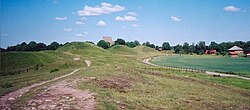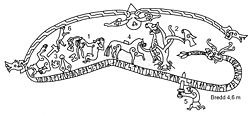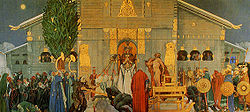The beginning

In the beginning there was the world of ice Niflheim, and the world of fire Muspelheim, and between them was the Ginnungagap, a "grinning (or yawning) gap," in which nothing lived. In Ginnungagap , the fire and the ice met, and the fire of Muspelheim licked the ice shaping a primordial giant Ymir and a giant cow, Auðumbla whose milk fed Ymir. The cow licked the ice, creating the first god, Búri , who was the father of Borr , in turn the father of the first Æsir, Odin, and his brothers Vili and Ve . Ymir was a hermaphrodite and alone procreated the race of giants. Then Borr's sons; Odin, Vili, and Ve; slaughtered Ymir and, from his body, created the world. From his skull, Odin, Vili, and Ve created the vault of the sky, which was supported by four dwarfs: Austri, Vestri, Sudri, and Nordri.
The gods regulated the passage of the days and nights, as well as the seasons. The first human beings were Ask and Embla (ash and elm ), who were carved from the wood of two trees and brought to life by the gods Odin, Hœnir /Vili, and Lóðurr /Vé. Odin gave them life; Vili gave consciousness; and Ve provided senses. Sol is the goddess of the sun, a daughter of Mundilfari , and wife of Glen . Every day, she rides through the sky on her chariot, pulled by two horses named Alsvid and Arvak . This passage is known as Alfrodull , meaning "glory of elves," which in turn was a common kenning for the sun. Sol is chased during the day by Skoll, a wolf that wants to devour her. Solar eclipses signify that Skoll has almost caught up to her. It is fated that Skoll will eventually catch Sol and eat her; however, she will be replaced by her daughter. Sol's brother, the moon, Mani, is chased by Hati, another wolf. The earth is protected from the full heat of the sun by Svalin , who stands between the earth and Sol. In Norse belief, the sun did not give light, which instead emanated from the manes of Arvak and Alsvid .
The sybil describes the great ash tree Yggdrasil and the three norns (female symbols of inexorable fate; their names; Urðr (Urd ), Verðandandi (Verdandi ), and Skuld ; indicate the past, present, and future), who spin the threads of fate beneath it. She describes the primeval war between Æsir and Vanir and the murder of Baldr. Then she turns her attention to the future.
The end times (Eschatological beliefs)
The Old Norse vision of the future is bleak. In the end, it was believed, the forces of chaos will outnumber and overcome the divine and human guardians of order. Loki and his monstrous children will burst their bonds; the dead will sail from Niflheim to attack the living. Heimdall , the watchman of the gods, will summon the heavenly host with a blast on his horn. Then will ensue a final battle between order and chaos (Ragnarök), which the gods will lose, as is their fate. The gods, aware of this, will gather the finest warriors, the Einherjar , to fight on their side when the day comes, but in the end they will be powerless to prevent the world from descending into the chaos out of which it has once emerged; the gods and their world will be destroyed. Odin himself will be swallowed by Fenrir.
Still, there will be a few survivors, both human and divine, who will populate a new world, to start the cycle anew. Or so the sybil tells us; scholars are divided on the question whether this is a later addition to the myth that betrays Christian influence. If pre-Christian, the eschatology of the Völuspá may reflect an older Indo-European tradition related with the eschatology of Persian Zoroastrianism .
Kings and heroes
The mythological literature relates the legends of heroes and kings, as well as supernatural creatures. These clan and kingdom founding figures possessed great importance as illustrations of proper action or national origins. The heroic literature may have fulfilled the same function as the national epic in other European literatures, or it may have been more nearly related to tribal identity. Many of the legendary figures probably existed, and generations of Scandinavian scholars have tried to extract history from myth in the sagas .
Sometimes the same hero resurfaces in several forms depending on which part of the Germanic world the epics survived such as Weyland /Völund and Siegfried /Sigurd , and probably Beowulf /Bödvar Bjarki . Other notable heroes are Hagbard , Starkad , Ragnar Lodbrok , Sigurd Ring , Ivar Vidfamne and Harald Hildetand . Notable are also the shieldmaidens who were "ordinary" women who had chosen the path of the warrior. These women function both as heroines and as obstacles to the heroic journey.
Norse worship
Centres of faith

The Germanic tribes rarely or never had temples in a modern sense. The Blót, the form of worship practiced by the ancient Germanic and Scandinavian people resembled that of the Celts and Balts : it could occur in sacred groves . It could also take place at home and/or at a simple altar of piled stones known as a "horgr ". However, there seems to have been a few more important centres, such as Skiringsal , Lejre and Uppsala . Adam of Bremen claims that there was a temple in Uppsala (see Temple at Uppsala ) with three wooden statues of Thor, Odin and Freyr.
Priests
While a kind of priesthood seems to have existed, it never took on the professional and semi-hereditary character of the Celtic druidical class. This was because the shamanistic tradition was maintained by women, the Völvas . It is often said that the Germanic kingship evolved out of a priestly office. This priestly role of the king was in line with the general role of godi , who was the head of a kindred group of families (for this social structure, see norse clans ), and who administered the sacrifices.
Despite the Shamanistic Völvas , this religion was not a form of Shamanism .
Human sacrifice
A unique eye-witness account of Germanic human sacrifice survives in Ibn Fadlan 's account of a Rus ship burial , where a slave-girl had volunteered to accompany her lord to the next world. More indirect accounts are given by Tacitus , Saxo Grammaticus and Adam von Bremen .
However, the Ibn Fadlan account is actually a burial ritual. Current understanding of Norse mythology suggests an ulterior motive to the slave-girl's 'sacrifice'. It is believed that in Norse mythology a woman who joined the corpse of a man on the funeral pyre would be that man's wife in the next world. For a slave girl to become the wife of a lord was an obvious increase in status. Although both religions are of the Indo-European tradition, the sacrifice described in the Ibn Fadlan account is not to be confused with the practice of Sati .
The Heimskringla tells of Swedish King Aun who sacrificed nine of his sons in an effort to prolong his life until his subjects stopped him from killing his last son Egil . According to Adam of Bremen, the Swedish kings sacrificed male slaves every ninth year during the Yule sacrifices at the Temple at Uppsala. The Swedes had the right not only to elect kings but also to depose them, and both king Domalde and king Olof Trätälja are said to have been sacrificed after years of famine.
Odin was associated with death by hanging, and a possible practice of Odinic sacrifice by strangling has some archeological support in the existence of bodies perfectly preserved by the acid of the Jutland (later taken over by Danish people) peatbogs , into which they were cast after having been strangled. An example is Tollund Man . However, we possess no written accounts that explicitly interpret the cause of these stranglings, which could obviously have other explanations.

